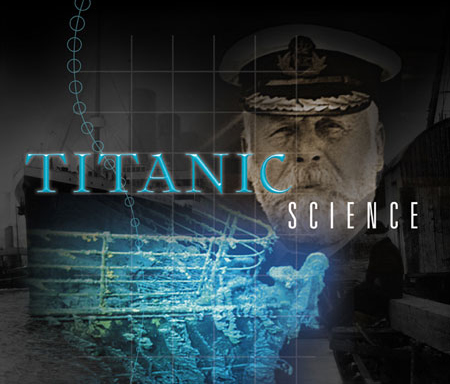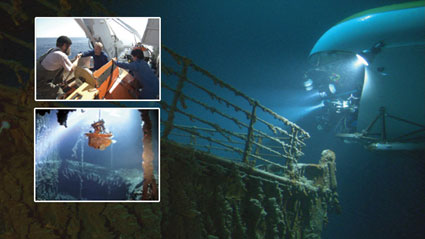
The Real Artifacts, The True Stories
Visitors to Carnegie Science Center can immerse themselves
in Titanic Science—trying their hands at skippering
a ship and dodging icebergs, or eating snow cones while
learning about the science of ice.
“
Bringing an exhibit that focuses on the gripping
tale of how the R.M.S. Titanic sunk on April 15,
1912, was
an easy choice,” says Dennis Bateman, Carnegie
Science Center’s director of creative services
and science content. The exhibit Titanic Science:
The Real Artifacts, The True Stories was developed by the Maryland Science Center in Baltimore. “The
Titanic has ongoing appeal, and there has been renewed
interest since the blockbuster feature film a few
years back,” he adds.
The Titanic began its
maiden voyage on April 10, 1912, when it left Southampton,
England, to travel
to New
York. Believed to be a cruise ship that could never
sink, the Titanic struck an iceberg at 11:40 p.m.
on April 14 and sank just a few hours later on
April 15.
Of the 2,227 passengers and crew on board, 1,522
died.
The Science Center exhibit displays artifacts
found on the ship when its remains were discovered
in
1985. The sunken ship with its treasures still
lies at
a site 963 miles northeast of New York City and
453 miles
south of Newfoundland.
Among the artifacts on
display are reading glasses that belonged to a passenger
or crew member,
a leather satchel, and a piece of printed sheet
music
titled “Put
Your Hand Around Me, Honey.” Some delicate
items, like paper and leather, survived because
the wreck
site is 2.5 miles below the ocean surface where
there is little light or oxygen. Many of the exhibit’s
interactive features explore the science of
why the Titanic sunk. For example, visitors
can maneuver images on an interactive screen
to learn about the so-called “bank suction” phenomenon,
which occurs when a large ship passes close
to another object, such as a dock or iceberg.
In
the Titanic’s
case, the ship actually hit the iceberg at
least six times due to the bank suction phenomenon.
Visitors
also can maneuver a remote-controlled
vehicle inside a 5,000-gallon tank of water.
Such devices
were used to explore the Titanic wreck and
obtain several
artifacts. To complement Titanic Science and
the Omnimax® documentary
Ghosts of the Abyss, the Science Center’s
Overnighter and Kitchen Theater programs also
will incorporate
this theme. The 3rd floor Kitchen Theater features Chill
Out: The Science of Ice. “This
gives us a chance in a theater-style show to
delve deeper into
the Titanic and how frozen water can sink a
multi-ton ship. And at the end, everyone gets
snow cones,” Bateman
says.
Ghosts of the Abyss
Rangos Omnimax Theater, October 1, 2004 through
June 2005

Running concurrently with the Titanic Science
exhibit is an OMNIMAX® documentary, Ghosts
of the Abyss, that lets moviegoers dive into
the ocean depths for a glimpse of the R.M.S.
Titanic and flash back to scenes of the liner’s
luxurious splendor that no one has seen since
the night she sank in 1912. Hollywood filmmaker
James Cameron directed and produced Ghosts
of the Abyss in conjunction with
Disney and a large team of expert cinematographers
and ocean explorers. Cameron is best known
for his Academy Award-winning film Titanic.
He became
so intrigued by the ship’s history and
story that in the summer of 2001 he led an
expedition to the wreck itself.
While the ship’s
wreckage has been filmed many times since its
discovery in 1985, this
is the first time that a large-screen, 3-D
format film has been created
to take viewers into the bowels of the ship.
“The unique thing about this film is that
it takes you down to the wreck of the Titanic,
a place
just a few will ever witness firsthand,” says
Dennis Bateman, the Science Center’s
director of creative services and science content. “That’s
why this film is a once-in-a-lifetime opportunity.”
Much
of the equipment used to explore and film the
wreck in IMAX 3-D technology was made especially
for the Ghosts of the Abyss expedition. “The
film lets you look at the wreckage of a state
room and then it ‘morphs’ back
to what it really looked like in 1912. Rather
than
just seeing chunks of steel sitting at the
bottom of the ocean, the viewer has a very
emotional
experience,” explains Bateman.
Introducing
Pittsburgh’s
Most Unique Skybox
 Entertain your best customers;
celebrate your child's birthday; stage a family
reunion; host an evening your guests will never
forget. Where? At Pittsburgh’s new, most
unique venue . . . the Rangos Omnimax Theater’s
Skybox at Carnegie Science Center. Entertain your best customers;
celebrate your child's birthday; stage a family
reunion; host an evening your guests will never
forget. Where? At Pittsburgh’s new, most
unique venue . . . the Rangos Omnimax Theater’s
Skybox at Carnegie Science Center.
Imagine a private
setting where you can comfortably watch a film
while enjoying great conversation,
food, and drink. The Science Center can arrange
for catering—everything from gourmet meals,
to cocktails and hors d’oeuvres, to simply
snacks, movie popcorn, candy and drinks. You
can schedule a party around a current Omnimax® film
or make a special request from Carnegie Science
Center’s film library based on theater
availability.
To schedule a Skybox party, call
412.237.3400. The cost is only $300 to rent
the Skybox for
up to 25 people. Catering and movie tickets
are additional and priced separately based on
the
total number in your party.
Carnegie Science Center:
Open All Night

If you think Carnegie Science Center shuts down
on weekend evenings, get out your
x-ray night
vision glasses and look again.
The place is literally
humming as children and adults arrive at 7
p.m., with sleeping bags in
hand and energy levels high. The event could
be any one of a number of weekend overnight
programs that the Science Center holds throughout
the
year.
“
It’s a unique way to be part of the Science
Center and an experience our guests will never
forget,” says Jessica Stricker, director
of education experiences at the Center.
There
are three categories of overnighters. Those
based in the main building tend to be
aimed at
Boy Scouts, Girl Scouts, and other groups.
These overnight campers have a 45-minute, hands-on
science activity to do, as well as the chance
to visit the Science Center’s exhibits,
see an OMNIMAX® movie, and enjoy an evening
snack and breakfast. The average attendance
is 350 adults and children per overnighter.
And
there are lots of themed overnighters: this
year look for the Titanic, Halloween, and Railroad
Overnighters. Submarine-themed overnighters
are another popular
category, and while the campers can’t
sleep on the sub, they spend several hours
there before
retiring into the main building.
Similarly,
UPMC SportsWorks has overnighters that feature
an evening at the main building
and then private time in SportsWorks the next
morning until it opens to the public.
Cost for
overnighters at the main building and submarine
is $30 per person. UPMC SportWorks overnighters cost $35.
“
There’s always excitement being in a building
after it’s closed,” says Stricker. “And
even though 350 people sounds like a lot of people,
it’s not really many at all for us. Most
days we have 2,000 or 3,000 people in the building,
so our overnight guests really get a lot of quality
time with all the Science Center has to offer.”

October 22-23, 2004,
10 a.m.-5 p.m
This year, Carnegie Science Center presents its
6th Annual National Chemistry Week on Friday
and Saturday, October 22-23. The activities
will focus on the contributions of science
and chemistry to our health and wellness.
The
theme of Health and Wellness will be featured
at more than 25 tables that offer chemistry-related,
hands-on science experiments, activities, and
demonstrations. These activities are designed
for all ages and are hosted by corporations,
societies, and universities. The Science Center
will also present all-day shows in the Highmark
Science Stage Theater during these two special
days.
And on Friday October 22, it will host
a Girl Scout Overnighter at which participants
earn
a National Chemistry Week Girl Scout Patch.
Sponsors
for National Chemistry Week in Pittsburgh include
The Pittsburgh Section of the American
Chemical Society, the Spectroscopy Society
of Pittsburgh, the
Society For Analytical Chemists of Pittsburgh, and Bayer Corporation. Funds
contributed to the event help underwrite
the expenses of Girl Scout Overnighters
and school
group visits.
October’s
Total Lunar Eclipse
By Dan Malerbo
 If the weather cooperates on October 27 we are
in for a special treat: a total eclipse of the
moon. Eclipses have been described as an example
of the “clockwork” of the universe.
They are regular, predictable, easy to watch
and one of nature’s grand spectacles. If the weather cooperates on October 27 we are
in for a special treat: a total eclipse of the
moon. Eclipses have been described as an example
of the “clockwork” of the universe.
They are regular, predictable, easy to watch
and one of nature’s grand spectacles.
A
lunar eclipse occurs at full moon when the
moon passes through the Earth’s shadow.
The shadow is made up of two cone-shaped components
nestled inside the other. The penumbra, or
outer shadow, is where the Earth blocks part
of the
sun’s rays from reaching the moon. The
umbra, or inner shadow, is a region where Earth
blocks all direct sunlight from reaching the
moon.
Lunar eclipses do not occur every time
we have a full moon because the plane in which
the
moon orbits is tilted five degrees. Because
of this
tilt, the moon usually travels above or below
Earth’s shadow each month.
A total lunar
eclipse occurs when the entire moon passes
through Earth’s umbral shadow.
Once the moon touches the edge of the umbral
shadow, (8:14 p.m. October 27) it takes about
an hour to be immersed completely and totality
to begin. Totality during the October 27 eclipse
begins at 9:23 p.m. and lasts 71 minutes—it
ends at 10:44 p.m.
During totality, the moon
can take on an array of colors from dark brown
and red to bright
orange and yellow. The exact color depends
on how much
dust and clouds are present in Earth’s
atmosphere, which filters the sun’s light.
Sometimes the moon can become invisible especially
after the eruption of a volcano. The volcanic
dust blocks sunlight from passing through earth’s
atmosphere to the moon.
No special equipment
is required to view a lunar eclipse. Just
go outside and look up.
Back to Contents |